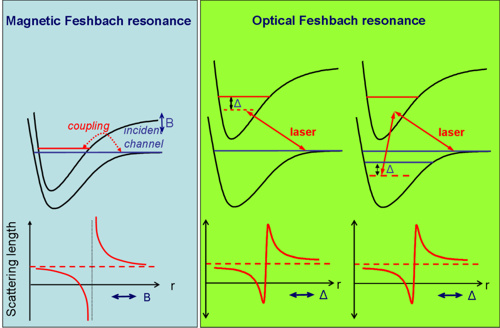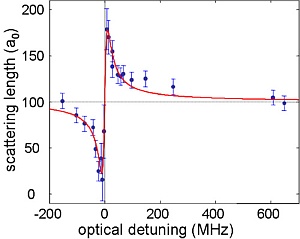Optical Feshbach resonances
Feshbach resonances can be used to tune the interaction between atoms. With the help of magnetically tunable Feshbach resonances it was possible to produce ultracold molecules, create molecular BECs, and observe interesting new phenomena as for example the “Bose-Nova” explosion of an atomic BEC.
A Feshbach resonances appears when two colliding atoms are resonantly coupled to a bound molecular state. This can dramatically change the collision properties which for ultracold collisions is typically expressed in terms of the scattering length.
When the scattering length is positive, the atoms effectively repel each other. When the scattering is negative, there is an effective attraction between the atoms. At zero scattering length there is effectively no interaction between the atoms.
So far only magnetically tunable Feshbach resonances have been used. The atomic scattering state is tuned into resonance with the molecular state by changing the magnetic field and using the Zeeman effect.

Optical Feshbach resonances are very similar to magnetic Feshbach resonances. They use a laser field to couple the atomic scattering state to the molecular bound state (using a so-called photoassociation transition). The concept behind optical Feshbach resonances is very general. For example optical Feshbach resonances can also be based on two-photon transitions. (see . G. Thalhammer et al., Phys. Rev. A 71, 033403 (2005), cond-mat/0409552)
Optical Feshbach resonances have been predicted by P. Fedichev et. al., PRL 77, 2913 (1996) and J. Bohn and P. Julienne, PRA 56, 1486 (1997).

We have experimentally demonstrated for the first time that you can change the scattering length with such an optical Feshbach resonance.
- M. Theis et al., Phys. Rev. Lett. 93, 123001 (2004). cond-mat/0404514
- G. Thalhammer et al., Phys. Rev. A 71, 033403 (2005). cond-mat/0409552
Compared to magnetical tunable Feshbach resonances, optical Feshbach resonances have some advantages:
- In contrast to magn. Feshbach resonances, optical Feshbach resonances are always available
- Light fields can be switched and controlled much faster than magnetic fields
- Light fields can be focussed much better than magnetic fields. This allows spatially addressing groups of atoms.
